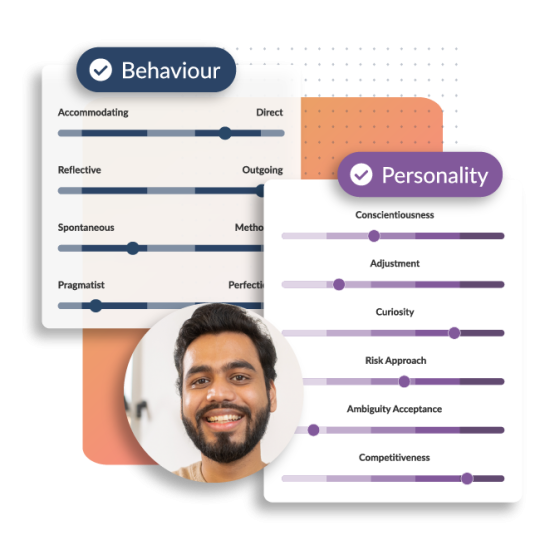Succession Planning & Talent Management
Plan to succeed and beat the skills gap
Finding your future leaders and managers can be tough. Nurturing your in-house talent can be more efficient and cost-effective than looking outside the business. It makes the selected employees feel engaged and valued while helping to retain valuable knowledge and skills. The next step then is to identify the right succession planning tools.


The profile of a leader is changing

Today’s leaders and managers need to be able to adapt and develop new skills to support their people in this ever-changing world of work. But how do you find individuals with the adaptability, empathy and inclusivity required?

Your longest-serving staff or current high achievers may not be the best candidates for management or leadership. Thomas Perform predicts professional success based on psychological indicators, helping you nurture your managers and leaders.

Grow your own
Investing in your team's growth often proves more economical and boosts engagement as employees see clear career progression.
With Thomas’ people science insights, you can objectively identify the traits and capabilities that matter most in managers and leaders, minimising the effects of unconscious bias. Insights into their strengths and development areas help individuals understand their potential and plan the evolution of their careers.
Discover your new work superpower
Frequently Asked Questions
<h6 id>What is succession planning?</h6 id>
Succession planning is the process of identifying and developing internal talent to eventually take on key roles within an organisation in the future. It requires a structured and systematic approach where key roles and suitable candidates are identified, candidates are put through a robust development process where they’re continuously assessed, and transition plans are created to facilitate appropriate knowledge transfer.
<h6 id>How can succession planning tools help my business?</h6 id>
Succession planning tools are designed to facilitate and streamline this process, often allowing for the rapid development of a detailed strategy that would otherwise take up a massive amount of time and resources. They can help remove bias from the candidate identification process, and give valuable data-backed evidence around developmental areas and career evolution.
<h6 id>When should a company start using succession planning tools to prepare for future leadership transitions?</h6 id>
The earlier you begin, the more likely your organisation is likely to be in identifying quality candidates and developing them to a requisite level. Using succession planning tools early in the process also allows you to get the most benefit from the data and insights they can provide.
<h6 id>What are the key benefits of utilising specialised succession planning tools?</h6 id>
Succession planning tools offer several benefits to any organisation, regardless of what stage they’re at in their succession planning journey:
- Bias-free talent identification based on skills and competencies that you can select.
- Targeted development plans that consider your candidates’ existing strengths and weaknesses.
- Skill gap analysis to discover where your internal talent pool may be lacking concerning the key roles you’ve outlined.
- A centralised data platform makes it easy to store, track, and manage data related to your succession planning process.
- Advanced reporting and analytics enable you to see the effectiveness of your strategy and allow you to make changes if necessary based on the data.
- Automation of certain parts of the succession planning process, allows you to streamline your succession planning so you can save time and resources.
- Quicker decision-making results from access to advanced data and analytics.
<h6 id>How can succession planning tools assist in identifying and developing potential successors within my organisation?</h6 id>
Once you have a pool of candidates, you can also use these tools to plan bespoke development programs that take into account the skills you’re looking for, and their current strengths and weaknesses. All of this will lead to a stronger set of future leaders within your organisation, reduced fear around any transitions, and increased employee engagement as they can see the effort and resources being put into their personal development.
<h6 id>Can succession planning tools be customised to fit the unique needs and structure of my business?</h6 id>
Absolutely. Our succession planning tools can be customised to fit your organisation's specific needs. You can define the types of roles you want to fill, the competencies and skills required from potential candidates, and even the individual development plans of your employees. You can develop custom performance evaluation criteria and tailor the analysis and reporting to suit your company’s requirements. Succession planning tools are made to give you exactly what you need. No two organisations are the same, so no two succession plans should be the same. With the high degree of flexibility offered by our tools, we’re confident you’ll be able to create the perfect platform for your succession plan.
<h6 id>How can the implementation of succession planning tools mitigate risks associated with key personnel leaving the organisation?</h6 id>
By using succession planning tools you can ensure that you have a solid pipeline of potential successors for any key role. This will ensure whoever assumes the position will be ready far quicker than a typical successor. This will also allow you to dramatically reduce the transition time from one leader to the next.
Using succession planning tools will also ensure that people assuming leadership positions will be developed with the exact role and organisation in mind. Your internal promotions will be equipped with the right skills and competencies much earlier in the transition process, meaning the risk associated with any transition dramatically decreases.
Finally, being able to leverage the vast amounts of data that succession planning tools can generate will lead to less hasty and more informed decisions around any transitions — facilitating less risk and improving organisational stability.
<h6 id>How can I get started with selecting and utilising the right succession planning tools for my business?</h6 id>
When choosing a succession planning tool, it always pays to be informed. Make sure you conduct appropriate research into a host of tools to see which, if any, are best suited to your organisation's needs. First, assess your specific needs and define the goals you’d like to achieve when it comes to succession planning. Make sure to take a look at what type of data you can get from the tool, and assess the platform’s dashboard to ensure it’s user-friendly and meets your organisation’s requirements.
Of course, if you‘d like to get a more comprehensive and bespoke introduction experience you can always request a demo of our succession planning tools and figure out just how much our tools could save you in the long run.


